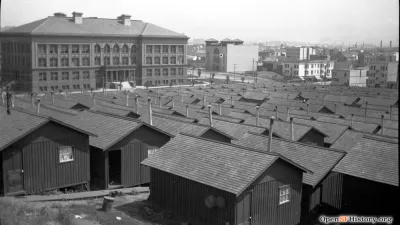Is gentrification the inevitable result of land use planning that reduces greenhouse gas emissions by favoring infill development over auto-dependent sprawl? The Urban Displacement Project looks at the unintended effects of Plan Bay Area.
Plan Bay Area, adopted to reduce transportation-cause greenhouse gas emissions as required by the landmark Sustainable Communities and Climate Protection Act of 2008 (aka SB 375), has survived four law suits. Now the MetropolitanTransportation Commission (MTC), which is implementing the plan along with the Association of Bay Area Governments (ABAG), and the California Air Resources Board (CARB), which approved the greenhouse gas reductions associated with the plan, "commissioned (a) study to examine the potential for low-income residents to be uprooted by implementation of Plan Bay Area," writes Richard Halstead for the Marin Independent Journal.
The study was authorized "in response to concerns raised by advocates for low-income Bay Area residents," adds Halstead.
"Miriam Zuk, postdoctoral research fellow at the Center for Community Innovation at UC Berkeley's Institute Of Urban And Regional Development who directed the Urban Displacement Project," said the research project confirmed the findings of previous smaller-scale studies," writes Halstead.
“When you open up transit and create amenities around transit, property values go up,” Zuk said, “and when property values and rents go up, some people can no longer afford to live in those neighborhoods.
Halstead writes about two of the lowest income areas in Marin County that heretofore may not have been as affected by the ongoing Bay Area gentrification than wealthier enclaves: Marin City, population 2,666, which is unincorporated despite then name, and the Canal neighborhood of San Rafael, county seat and "Marin's largest city, with a population of 57,713," according to the Marin Independent Journal.
Canal Neighborhood:
According to the study, the Canal’s Hispanic population increased from 47 percent in 1990 to 80 percent in 2013; the neighborhood’s overall population grew by 50 percent between 1990 and 2013 without a commensurate increase in the stock of housing.
To afford rents, many Canal residents pack into units resulting in significant overcrowding. The study reports that “it is not uncommon for three to four families to live in one unit, each family living in one bedroom, with as many as ‘eight or more persons’ in a two-bedroom apartment.” There are many multifamily rental buildings located in the neighborhood.
The study concludes, “When the SMART train station opens in San Rafael, the Canal area will be at risk of gentrification.” It states that the “Canal’s limited area to develop new housing, high renter rate, high levels of poverty, low incomes, and lack of affordable housing put it potentially at risk for displacement.”
Marin City
(T)he study reports the African American population there decreased from 75 percent in 1980 to 42 percent in 2013. A third of Marin City’s population, some 698 people, live in public housing managed by the Marin Housing Authority.
“There is less risk of immediate displacement pressure in Marin City at least among the community that is in public housing,” Zuk said.
But, the study concludes, “There is a constant fear that these public housing units will be lost, given the area’s high land value and views of the Bay, as well as recent unfriendly policies and deferred maintenance.”
In "Can Gentrification Integrate Neighborhoods?", Philip Rojc, contributing editor at Planetizen, explores the same topic as it applies to Latino barrios in eastern Los Angeles.
The gentrification risks to Marin County tied to increased infill growth "conflict with the expectation of some Marin opponents of Plan Bay Area who predicted implementation of its policies would attract more low-income residents, not displace them," writes Halstead.
Listen to Zuk explain the Urban Displacement Project's findings in a call-in, half-hour radio show on KQED's Forum, "UC Berkeley Study: Gentrification Crisis is 'Not Yet Half Over'".
FULL STORY: Study: Marin City, Canal among Bay Area communities at high risk for gentrification

Alabama: Trump Terminates Settlements for Black Communities Harmed By Raw Sewage
Trump deemed the landmark civil rights agreement “illegal DEI and environmental justice policy.”

Planetizen Federal Action Tracker
A weekly monitor of how Trump’s orders and actions are impacting planners and planning in America.

The 120 Year Old Tiny Home Villages That Sheltered San Francisco’s Earthquake Refugees
More than a century ago, San Francisco mobilized to house thousands of residents displaced by the 1906 earthquake. Could their strategy offer a model for the present?

In Both Crashes and Crime, Public Transportation is Far Safer than Driving
Contrary to popular assumptions, public transportation has far lower crash and crime rates than automobile travel. For safer communities, improve and encourage transit travel.

Report: Zoning Reforms Should Complement Nashville’s Ambitious Transit Plan
Without reform, restrictive zoning codes will limit the impact of the city’s planned transit expansion and could exclude some of the residents who depend on transit the most.

Judge Orders Release of Frozen IRA, IIJA Funding
The decision is a victory for environmental groups who charged that freezing funds for critical infrastructure and disaster response programs caused “real and irreparable harm” to communities.
Urban Design for Planners 1: Software Tools
This six-course series explores essential urban design concepts using open source software and equips planners with the tools they need to participate fully in the urban design process.
Planning for Universal Design
Learn the tools for implementing Universal Design in planning regulations.
Clanton & Associates, Inc.
Jessamine County Fiscal Court
Institute for Housing and Urban Development Studies (IHS)
City of Grandview
Harvard GSD Executive Education
Toledo-Lucas County Plan Commissions
Salt Lake City
NYU Wagner Graduate School of Public Service



























